The #1 Tip to Increase Milk Production
Have you noticed a drop in your milk production? Do you have concerns about maintaining your milk? Are you looking to increase your milk production? Then you’re in the right place.
When my daughter was 9 months old, I decided to try some gentle sleep training. Up until then, Roo was a frequent feeder overnight. But she started sleep longer stretches, and I took advantage by also sleeping. Despite knowing better, that sleep felt so good, and so I frequently skipped pumping in the middle of the night. I would dream feed around 11pm and then Roo wouldn’t wake again until 5 am. Surely a 6 hour stretch wouldn’t have much impact on my supply. But within a month, my borderline oversupply dropped to less than half of what I needed per day. Suddenly, I desperately needed to increase my milk production.
Now, every time I hear a mama mention that their milk supply has dropped, there is one question that immediately pops in to my head.
“How often do you feed or pump during the night?”
More often than not, baby has started sleeping longer stretches at night, or some kind of sleep training has been implemented, and baby is not feeding as frequently. There are multiple factors that impact milk production, but one of the biggest roadblocks to maintaining supply is not emptying the breast overnight.
And that’s why the middle of the night (MOTN) milk removal is crucial.
Night Time Magic
Fun fact: All nursing mammals sleep with their babies.
What is it about night time that is so critical to milk production? Milk supply is highest in the early hours of the morning. How baby feeds during the night determines the milk supply for the next 24 hours. A lot of it boils down to hormones and biological norms when it comes to infant sleep. Not only that, but you’ve probably heard that milk production is supply and demand. If baby is sleeping half of the day and those feedings aren’t replaced by pump sessions, then your milk production will drop. Half the demand equals half of the supply. It won’t happen immediately, but it will happen. Why?
It’s all about the hormones
There are two hormones that are primarily responsible for breastfeeding. Prolactin is responsible for milk production and oxytocin is responsible for the release, or let down, of milk. Prolactin levels change throughout the day and are highest over night, and in the very early hours of the morning. It is also stimulated through suckling. Every time baby feeds (or you pump), prolactin levels rise to produce milk for the next feed. If milk removals are occurring at regular and consistent intervals, prolactin ensures that there will be milk for the next feed.
You make the most milk overnight because prolactin levels are the highest. If baby is feeding during the night, these will be some of the largest feeds that baby receives all day, and can actually make up the bulk of the calories that baby needs for the day. But because suckling promotes prolactin, whatever stimulation occurs during the night will have a trickle down effect for the entire day. Simply put, frequent overnight milk removals lead to more milk during the day. Less or no milk removals over night lead to less milk during the day and possibly very low milk in the evenings.
With rising prolactin levels at night, milk supply starts to increase around midnight, with peak levels occurring around 2-3am. This is the magic window for a middle of the night milk removal.
Supply and demand
I mentioned above that milk production is supply and demand, but what does that mean? Every time milk is removed from the breast (demand) the body is told to make more milk (supply). Empty breasts make milk faster.
The breast can only hold so much milk. This is referred to as storage capacity, and it’s different for every woman (and is not related to breast size). When too long of an interval between milk removals has occurred, the breast reaches maximum capacity and signals are sent to the brain to slow down milk production. Full breasts make milk slower.
Over time, the body reads the signals and adjusts milk production accordingly. If the breasts are frequently empty, milk production will increase to meet the demand. If breasts are frequently full, milk production will down regulate to meet the lack of demand.
With prolactin levels at their highest overnight, breasts fill up more quickly. If that milk is not being removed, frequently and consistently, the body reads these signals as a lack of demand and milk production will drop. Therefore, the middle of the night pump ensures adequate milk removal so that the breasts remain empty, sending the important milk making signals to the brain, to increase milk production.
Biology, baby
Baby sleeping separately from mom is a modern construct. Historically speaking, baby shared the family bed and had open access to the breast all night, every night. Having baby near ensured that those milk making hormones remained high. Babies frequently suckle for comfort, but that stimulation to the nipple still sends important milk making messages. And most importantly, baby would sip throughout the night, continuously topping himself off, while ensuring that the breasts were being drained. Empty breasts make milk faster.
This behavior has transpired for millennia, and as such, both mamas and babies alike are hard wired to protect milk supply through night feeding. Baby demands all night long, so mama’s supply responds, and that cycle repeats and maintains itself.
So what happens when we keep baby from the breast for long stretches? Without that stimulus, mama’s body thinks that there is no longer a need to produce so much milk, and her supply drops. Not immediately. Ultimately, she wants to protect her supply, so the occasional long stretch won’t have a long lasting impact. But over time, within a few weeks or even months of skipping the night feedings, milk supply will down regulate, and then you might find yourself trying to play catch up.
Make It Happen
Hormones, supply and demand, and biology. These three things make the middle of the night pump the most important pump of your entire day. Missing out on that golden window of 2am-3am practically guarantees a drop in your milk supply. Waking up to pump during that time can solidify your supply so that you can continue to breastfeed as long as you both desire. And just the same as your supply didn’t disappear immediately, it will take some time for your body to ramp production back up. Consistency is key.
If baby seems increasingly more cranky in the evenings, you’ve noticed a drop in your supply, or baby has started sleeping longer stretches at night, take a look at your routine and see if there is room for a middle of the night pump. Not only will you gain some extra ounces to set aside for baby, but you will also tell your body that there is a hungry baby that needs everything you’ve got, and will kick your milk production in to gear. Adding that middle of the night pump will increase your overall milk supply.
Do you pump during the night? Let me know what’s been working for you!






